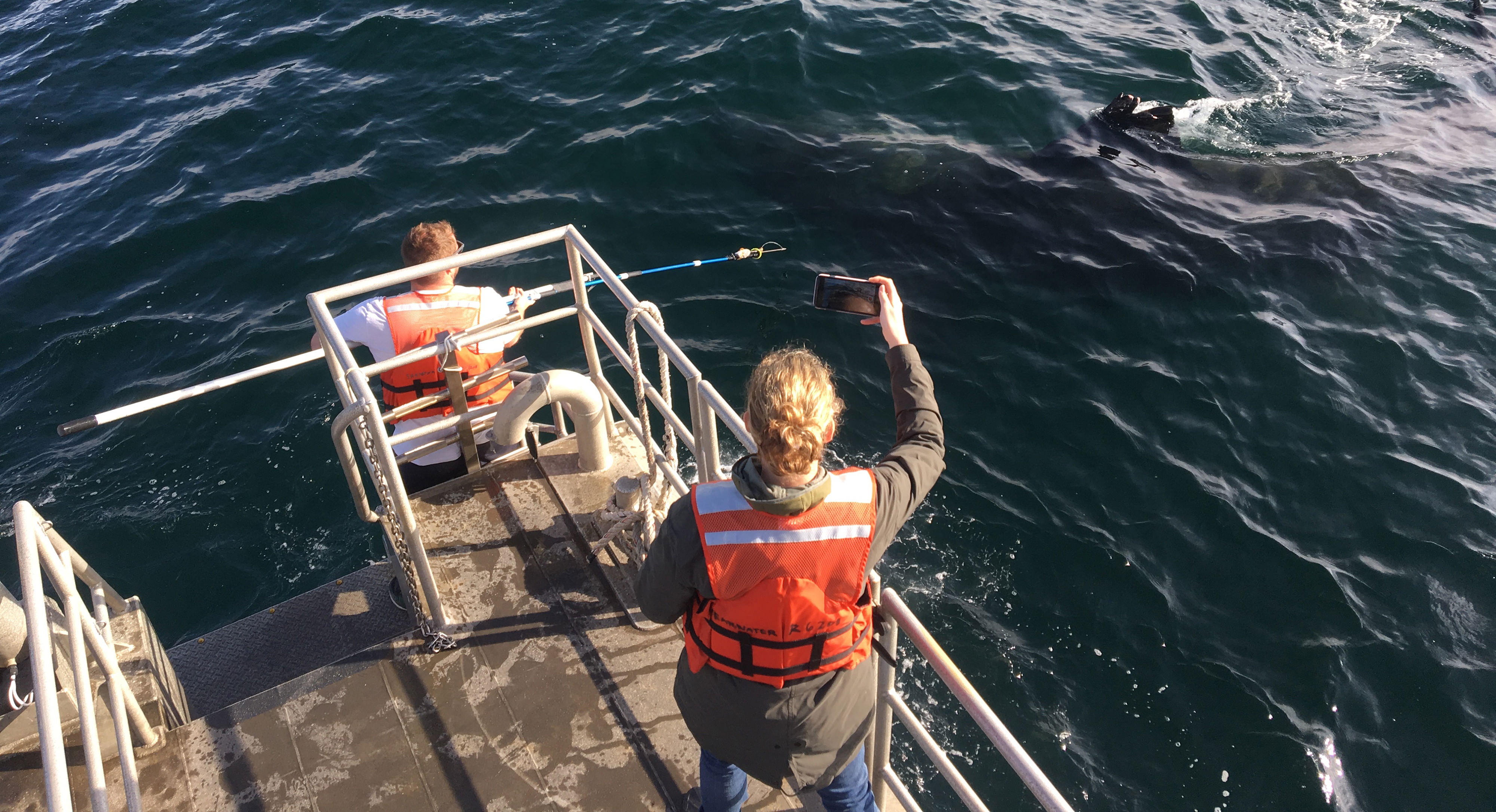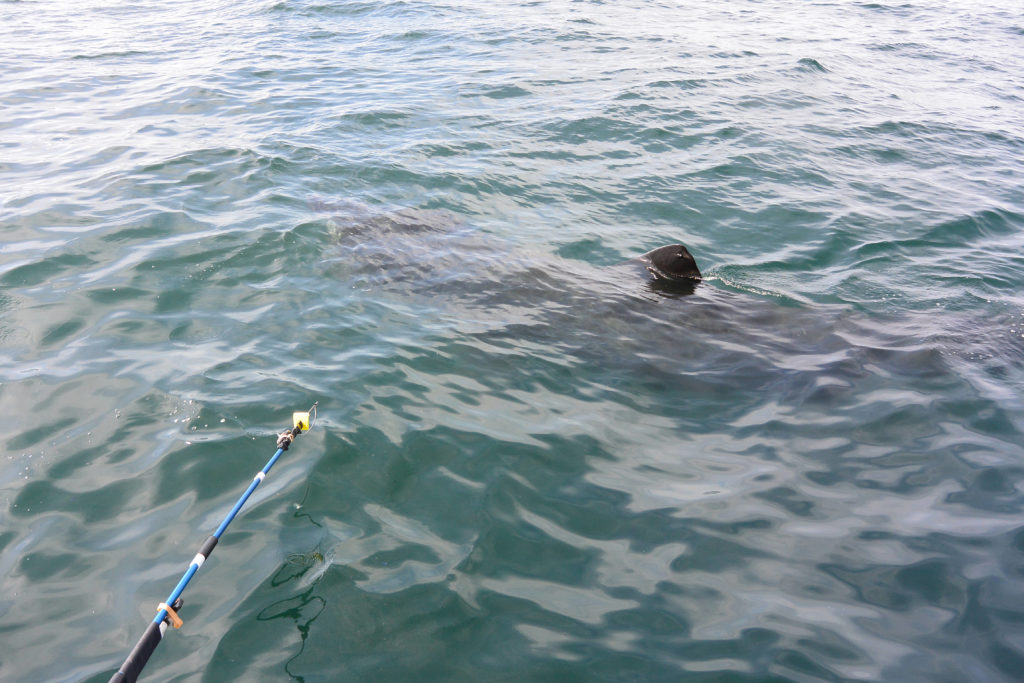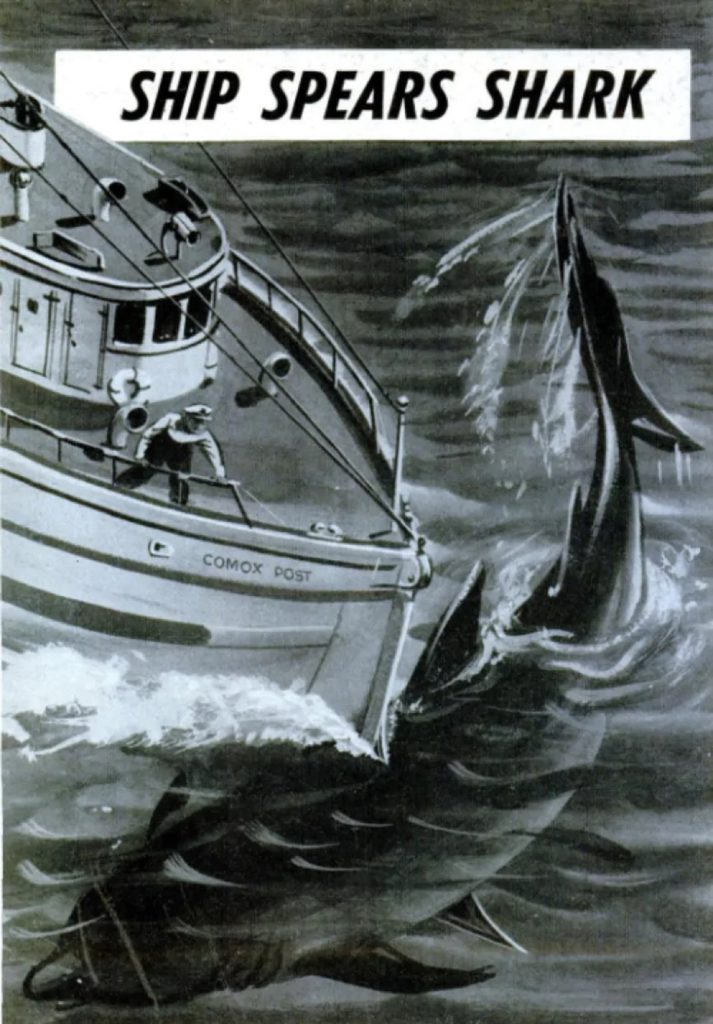
Basking sharks were once so abundant along the California coast that a thrill-seeking trophy hunter reportedly harpooned a half-dozen in under three hours in Monterey Bay. That was in 1947.
Today, the big fish are so rare that it’s taken a team of scientists between San Diego and Santa Cruz eight years to put tracking tags into just six animals. Their numbers are so low, in fact, that researchers, working with tiny sample sizes, can scarcely study them at all or draw firm conclusions about population trends, threats to their survival, typical behavior, or how global warming may affect them.
There is even concern that the sharks—filter feeders that may grow to 40 feet, the size of a small whale—are so widely scattered through the ocean that they may not be able to locate one another to mate and reproduce.
Sean Van Sommeran, founder of the Pelagic Shark Research Foundation in Santa Cruz and a collaborator in the ongoing tagging project, put a pop-off satellite tag into a Monterey Bay basking shark in 2011—a shark that produced migration data for a paper published last year in the journal Frontiers in Marine Science. He rejects the notion, sometimes floated in the media, that basking sharks are making a comeback.
“There’s more boat and air traffic today than ever before, and there are fewer sightings [of basking sharks] than ever before,” he says.
The fish were listed in 2010 as a “species of concern” by the National Marine Fisheries Service—a designation that vaguely calls for a better understanding of the animals but offers no clear research or conservation framework.
Van Sommeran thinks the animals should be granted a higher level of federal protection. “The criteria for endangered species status is pretty well accepted to be depletion to 10 percent of historic abundance,” he says. “Basking sharks are there, so why are they in this nebulous sidebar category of ‘species of concern’?”
Heidi Dewar, a researcher with the National Oceanic and Atmospheric Administration and the lead author on the recent paper, says listing a species as threatened or endangered is a complex process that depends on a species’ absolute population size, its potential for population rebound, and trends in population size. While there is no doubt that basking sharks are far less abundant than they once were, there is no evidence that the population, whatever it may be, is growing or shrinking.
“We just haven’t been able to study enough animals,” Dewar says. She says her team takes to the water in power boats when they receive eyewitness reports of the filter-feeding sharks cruising at the surface. Successful outings, though, have been few and far between. About four times out of five, she says, the sharks are gone by the time they arrive.
The low success rate makes each fruitful venture, with a tag jabbed with a long spear into a shark’s back, a cause for celebration. “It’s kind of like Wimbledon—we hug each other, throw our arms in the air, scream, celebrate,” Dewar says.
It’s also a high-stakes gamble. The tags, says coauthor Owyn Snodgrass, another NOAA scientist, cost several thousand dollars each. “It’s like throwing a laptop into the ocean for a few months and hoping it will work later,” he says.
The tags the scientists use are designed to break free from the fish and float to the surface after a preprogrammed period of time—usually a few months. At the surface, the tags transmit data skyward, and passing satellites bounce the signals to the researchers’ computers.
“It’s always a thrill when you open your computer and see that email telling you your tag has surfaced,” Snodgrass remarks.
For the researchers, the data generated by the tagged basking sharks has provided a glimpse into the ocean-wide migrations and day-to-day behavior of what is certainly one of the least-understood large marine animals. One of the six sharks tagged so far left the California coast, swam to Hawaii, and spent most of its time at depths of 800 to 1,500 feet beneath the surface. Another shark traveled south along the Baja California peninsula and came to the surface on a daily basis. Two more tags essentially malfunctioned, releasing after just nine days and 51 days, respectively, not far from the point of deployment. (Two more sharks were tagged after the paper was written.)
The tags from the longer migrations showed intriguing patterns of vertical movement through the water column. The fish tended to remain near the surface while in nearshore waters—probably taking advantage of coastal upwelling and the abundant plankton it helps generate. When they moved farther offshore, the sharks descended into deeper water.
The study solved few mysteries while laying a foundation for further investigations into where the fish go and whether these migrations place them in harm’s way.

“We want to know where they’re going and what fisheries they interact with,” Dewar says. She says the sharks, when caught in nets in international fisheries, are often killed for their large and valuable fins. She says this rarely, if ever, occurs in United States waters, where finning is prohibited.
Gregory Skomal, a biologist with the Massachusetts Division of Marine Fisheries who was not affiliated with Dewar’s research, says the California scientists’ paper provides “insight into the biology of the world’s second-largest fish.” (The whale shark is the world’s largest fish.) Skomal has studied basking sharks in the Atlantic Ocean. There, he says, “you can consistently locate them.”
Skomal notes that the scarcity of basking sharks in the Pacific Ocean doesn’t just make it difficult for scientists to study them; it can also have consequences for the very survival of the species.
“We just hope they haven’t become so rare that they can’t reproduce,” he says.
Historical accounts tell of fishermen and mariners seeing hundreds of basking sharks in a single day, and the fish—navigational hazards for boats—were considered pests. Off the coast of British Columbia, they were actively culled by the Canadian government by fitting boats with large blades on their bows designed to fatally injure the sharks in collisions. This eradication effort, which began in the 1940s and ended in 1970, removed somewhere between 1,000 and 2,600 basking sharks from the ocean.

They were treated similarly in California, where harpooning them for sport was a niche tourist attraction in Monterey Bay for several decades. This vulgar pastime, described by writer and historian Tim Thomas, persisted from the 1920s until the early 1950s—about the time when the sharks slipped into scarcity. According to the Frontiers in Marine Science paper, fishermen in California may have taken 700 to 800 basking sharks in the first half of the 20th century. So depleted is the West Coast’s basking shark population that only three have been incidentally caught by the Canadian groundfish trawl fleet since 1996.
But the history of the basking shark’s interactions with humans is not quite the typical linear storyline of a species driven from abundance to near extinction. In their paper, Dewar and her colleagues, referring to historical records, describe periods in the 19th century in which basking sharks would go unseen for 20 years at a time—a pattern indicating global migrations and other behaviors still not understood.
For now, scientists at the leading edge of studying the basking shark know virtually nothing about them: where they mate, where they give birth, why they leave productive coastal zones, to what degree regional populations intermingle, and so on.
“So much about basking sharks remains mysterious,” Skomal says. “Their age at maturity, their size at maturity, how long they live, how fast they grow—there is a tremendous amount we don’t know.”
Dewar and Snodgrass say they have plans to address some of these persisting mysteries in future research. But due to the difficulty of tagging and studying basking sharks, progress will come slowly. “It could be 10 years before the next paper is published,” Dewar says.
Basking Shark Decline, New York Times, 1995
Basking Sharks: The Slaughter of BC’s Gentle Giants, by Brian Gisborne and Scott Wallace
Basking Shark Movements in the Eastern North Pacific Determined Using Satellite Telemetry 2018 Paper, Frontiers of Marine Science
Top photo: NOAA crew works to tag a basking shark. Photo courtesy Sean Van Sommeran/Al Thevenen/NOAA